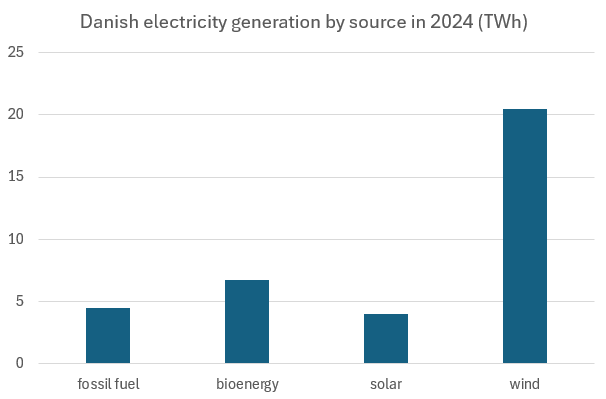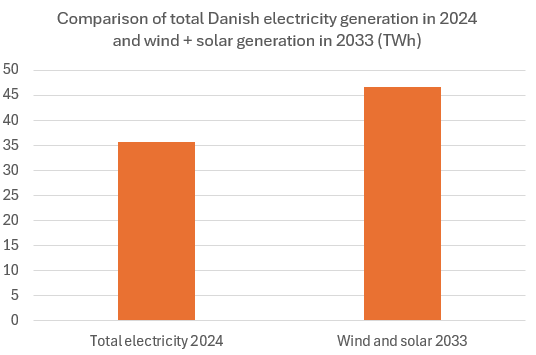Two stories: Denmark's soaring renewable success and global nuclear construction disaster
Denmark will soon achieve 100% electricity from wind and solar; but across the world nuclear power construction cost overruns soar
Two stories emerged on May 19th giving diametrically opposed results; one is very positive news for the booming deployment of renewable energy but the other is crushingly bad for nuclear power prospects. Renewables will make up more than of Danish 100% electricity in a couple of years time and just wind and solar not long after that. On the other hand a new study concludes that, around the world, nuclear power projects have cost overruns that are over 100%. Solar and wind have very low, if any cost overruns.
Danish renewables to reach 100 per cent of electricity
You can see the shares of electricity generation for Denmark in 2024 in Figure 1. Wind and solar already make up 69 per cent of generation and together with bioenergy they made up 87 per cent of electricity generation. But wind and solar generation is increasing rapidly. The different shares of power production can be seen in Figure 1.
Figure 1
Source: Ember
Denmark blazed the trail for wind power starting in the 1970s as farmers and wind cooperatives put up their own wind turbines. Initially the turbines were only 20 kW in peak output. But the latest planned offshore windfarm will have turbines of 20 MW in size - a thousand times bigger! The early start for wind power in Denmark boosted its industry tremendously. Today Denmark also hosts Vestas, the largest wind generator manufacturer in the world for turbines supplied outside China.
There are still a trickle of onshore wind turbines being built. However, these days most of the new wind capacity is coming from offshore wind. The 1.08GW Thor windfarm that is currently being built will be fully operational in 2027.
This means that by the end of 2027 Denmark will be generating 86% of its 2024 level of electricity consumption from wind and solar alone. This takes into account continued current levels of solar PV expansion, onshore wind and also the completion of the Thor offshore windfarm. Thus Denmark will be generating over 100% of its 2024 level electricity consumption from renewables as a whole by 2027.
However this solar and wind generation is going to increase to a much higher level by 2033. This is because, apart from more onshore wind and solar, a further 3 GW of offshore wind will be built. This will raise Denmark’s wind and solar electricity contrbution to 150% of the nation’s electricity consumption in 2024.
Confirmation of the latest batch of offshore wind to be issued contracts came on May 19th. The Danish Government announced that it was launching an auction of 3 GW worth of offshore wind contracts (see HERE). Contracts-for-difference (CFDs) will be auctioned off. This will give generators a guaranteed price for each unit of the electricity that is generated. The addition of these offshore windfarms will mean that Denmark is getting more than 100 per cent of its electricity from wind and solar.
Figure 2 shows the comparison of the projected wind and solar production in 2033 compared with wind and solar generation in 2024. It is true that electricity consumption (which currently mirrors electricity production) will increase alonsgide increases in electricity consumption by EVs and heat pumps. However this is unlikely to match the increase in wind and solar generation. This means that Denmark will be a net exporter of wind and solar in from 2033, generating over 100% of electricity from wind and solar.
Figure 2
Source: Ember data adapted using own projections for future developments (see text)
Academic study reveals enormous average nuclear cost overruns around the world
Meanwhile, on the same day as the announcement of the forthcoming auction for the Danish offshore windfarms, an academic paper was announced which showed truly awful results for the nuclear industry. The study scoured the world for details on as many energy infrastructure projects that coud reliably be found - 662 in all - including 204 nuclear power plant constructions.
The researchers found that the average cost overrun for nuclear power plant was a staggering 102.5 per cent. That means that the construction costs were more than double the cost that was originally estimated before the construction started. What makes this figure all the more remarkable is that this was an average across the whole of the world.
The study includes Eastern countries like China. In these states there is still the specialist industrial skills (and more relaxed health and safety at work regulations) required to deliver nuclear power stations at anywhere near their projected construction time. Yet, in western countries, the construction cost overruns are much worse. Essentially, in western conditions, it has become impossible to deliver nuclear power plant at anything below astonomical costs.
I should add that there is an incredble amount of nonsense being spouted at the moment about how ‘small modular reactors’ are some way of saving nuclear power. Apart from occasioning a small amount of ultra-expensive nuclear capacity they are nothing of the sort. They are much worse in economic terms than even conventional reactors. See my discussion ‘Why small modular reactors do not exist - history gives the answer’. See HERE.
It is a completely different matter for renewable energy projects of course, where cost overruns are very low. But, from the press coverage, you would not guess all of this! In Figure 3 you can see the comparison between nuclear power plant and other projects around the world in terms of cost overruns. Nuclear power is a special case where there are giant ovrruns in costs. I have just taken the technologies for which there are at least 50 examples each found by the researchers (data is also given in the paper for CCS, hydrogen, bioenergy and geothermal).
Figure 3
Source: ‘Beyond economies of scale: Learning from construction cost overrun risks and time delays in global energy infrastructure projects’ by B Sovacool and Hanee Ryee, Energy Research & Social Science Vol 123, May 2025, 104057, Table 1. See HERE
The study is published in the journal ‘Energy Research & Social Science’, and you can see some discussion of the paper HERE and the paper itself HERE. Energy Research & Social Science is a top-rated journal with a high average number of citations. Indeed, I have had three papers published in this journal, so it must be a very good journal!
As you can see from Figure 4, this is all just part of a trend whereby nuclear power is not expanding at all relative to the start of this century. On the other hand renewable energy (mostly wind and solar) is rapidly expanding.
Figure 4
Source: 2024 Energy Institute Statistical Review of World Energy
Conclusion
As we can see from this post Denmark is, within a few years, about to be the first country in the world with a net surplus of wind and solar power. Interestingly this is the country that turned its head against nuclear power forty years ago, although it never bult any nuclear power plant before then. I have heard an incredible amount of what could be described as nonsensical disinformation in the mainstream press about how nuclear power is accelerating around the world and even that is some sort of way renewables are in crisis. The reality is the exact opposite as the information in this post demonstrates.






Just looking at generation as you have done gives a highly misleading picture. According to IEA Denmark generates approximately 35 Terra Watts of electricity. It imports 16.7 Terra watts. In other words it could not have such a high renewable penetration without being plugged into Germany, Sweden and Norway. Most of the imports are generated by nuclear from Sweden or coal from Germany. The time when imports are highest is winter when the wind is low in the North Sea,but at that time all the North Sea littoral countries tend to be affected. So prices are very high. Denmark does export a similar amount of electricity although it is a net importer. Its exports tend to be when prices are very low because the Wind in the North Sea is good and summer means lower demand.
Denmark is very fortunate in having so many interconnectors to adjacent countries to support it when its dark and windless. Its also still runs many coal stations which it isn't in any rush to shut down.